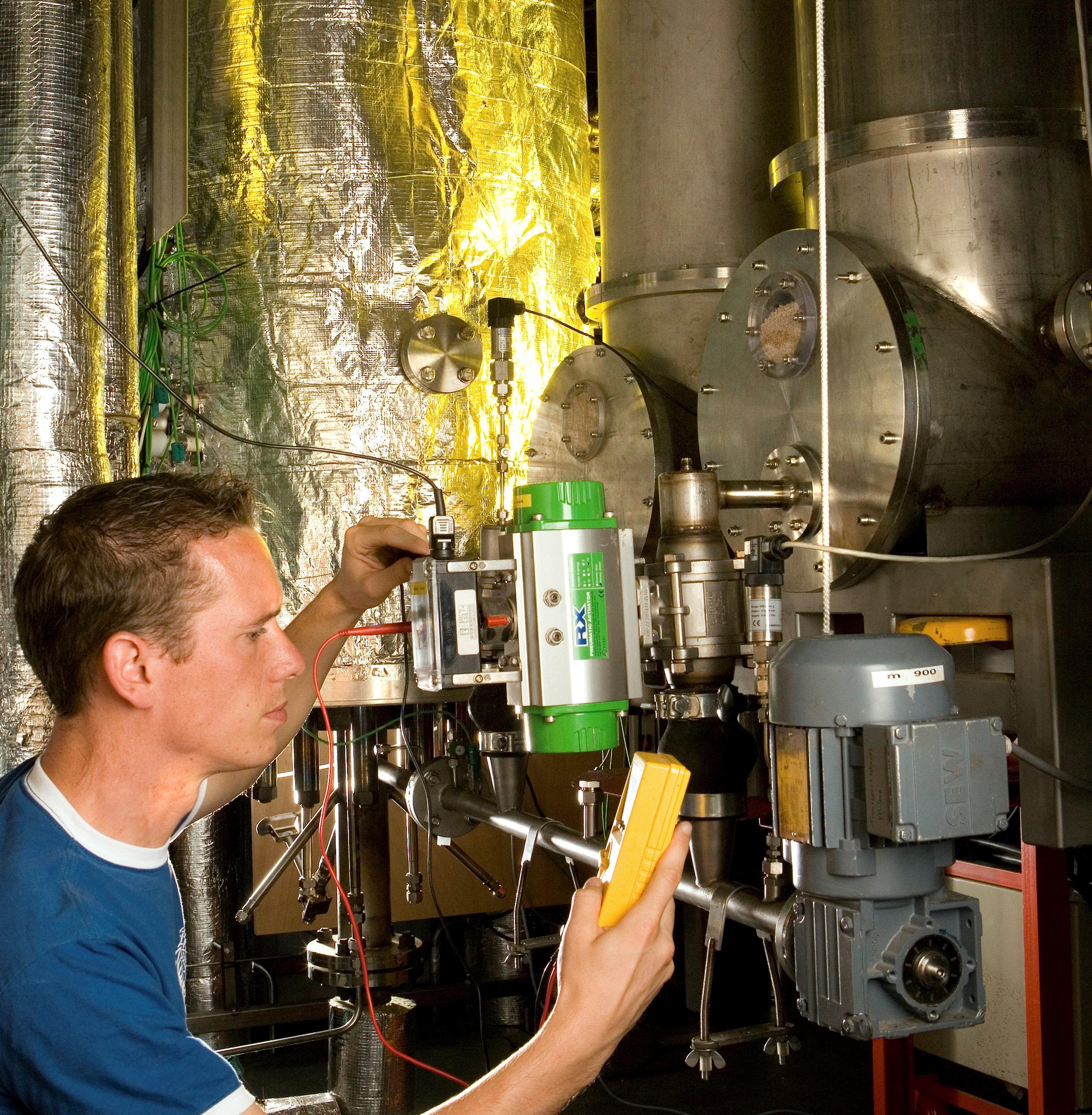
9 minute read
advanced biofuels
5
Gasification of solid biomass and intermediate energy carriers to advanced biofuels
Advertisement
An important research component of BECOOL focused on the optimization and integration of thermochemical conversion processes for advanced biofuel and biorefineries. This work had multiple objectives including: • generating experimental gasification performance data for lignocellulosic biomasses at bench scale; • validating the pyrolysis of selected feedstocks at bench and pilot scale for subsequent gasification; • assessing the performance and scale up costs of advanced biofuel value chains using AspenPlus models; • conducting a regulatory framework analysis of the definition and standards for advanced biofuels from gasification. Fig 33 below shows the different steps of the integrated process that was studied and tested. The production of Fischer-Tropsch biofuel via direct entrained flow fluidized bed biomass gasification was the main processing pathway. In addition, both fast pyrolysis and slow pyrolysis were studied as ways to produce intermediate energy carriers for further gasification and production of FT fuels (gasoline, diesel and kerosene). In the first case, the intermediate carrier was fast pyrolysis bio-oil (FPBO), and in the latter case the carrier was a slurry of char and bio-oil. Two main reasons justified the production of intermediate energy carriers before gasification. First, both slow and fast pyrolysis can provide advantages in solving logistical challenges, enabling a decentralized pretreament of the biomass in modular units, by producing the energy carriers (FBPO or slurry) at local level, before their final gasification and upgrading in a large-scale unit. Both solutions can also provide excess heat for the drying of the biomass, and in the case of slow pyrolysis, biochar is also produced, that can be used as a soil amendment and for soil carbon sequestration. The second advantage is at process level, as both fast and slow pyrolysis can separate the inorganic elements in the biomass that are responsible for ash melting behaviors during the gasification stage. Finally, the use of FBPO simplifies pressurized operation in the gasifiers, avoiding the need for further syngas compression.
Gasification of solid biomass
Regarding direct biomass gasification, successful tests were conducted by TNO on its proprietary MILENA gasifier, with biomass from eucalyptus, sugar cane bagasse, fiber sorghum, and giant reed. The conversion rates of eucalyptus and sugar cane bagasse were in line with the reference feedstock (wood chips) around 80-85% at 800°C. A higher gasification temperature resulted in a higher carbon conversion to gas. The feedstock from sorghum and giant reed was pelletized before gasification, to prevent the bridging of the feedstock in the bunker, and to densify the material in order to feed the required amount (~5 kg/h) into the gasifier. Expectedly, sorghum and giant reed resulted more challenging than eucalyptus due to their higher content of sulphur and nitrogen, and their carbon conversion to product gas was in the range of 65-75%.

Fig 34. Carbon conversion rates of gasification tests of eucalyptus (EUC), sorghum (SO), giant reed (GR), bagasse (BAG). Source: TNO.
Gasification of liquid intermediates
In addition to the tests on solid biomass samples, as part of the thermochemical experimental activities, in 2020 samples of giant reed, fiber sorghum and eucalyptus were converted into fast pyrolysis bio-oil (FPBO) by VTT in Finland and the bio-oil was then sent to BTG in the Netherlands, for bench scale gasification tests. The analysis of the oil showed that FPBO from eucalyptus had the highest heating value and the lowest ash and solid content of the three. These are positive aspects for gasification, although the viscosity of this oil was also the highest, affecting the atomization of the FPBO, while the viscosity of the other two samples was lower, partially due to a higher water content in the samples.
Feedstock Eucalyptus Arundo Sorghum
Water, wt %
Solids, wt%
MCR, wt%
Ash, wt %
Carbon, wt%
Hydrogen, wt%
Nitrogen, wt %
Chloride, mg/kg
Sulphur, mg/kg
Oxygen (by diff.), wt%
Viscosity (20 °C), cSt
Viscosity (40 °C), cSt
Viscosity (60 °C), cSt
Viscosity (80 °C), cSt
Density (20 °C), kg/dm3
Density (40 °C), kg/dm3
Density (60 °C), kg/dm3
Density (80 °C), kg/dm3
HHV, MJ/kg
LHV, MJ/kg
22.8 29.6 26.1 0.14 0.25 0.63 18.6 16.6 17.5 0.03 0.16 0.09 43.0 41.2 41.4 7.7 8.0 8.0 0.2 0.3 0.9 240 260 133 144 338 528 49 50 50
66 34 37 20 11 13 7.1 5.1 5.8 3.8 2.7 3.1
1.191 1.162 1.171 1.174 1.145 1.154 1.156 1.126 1.124 1.135 1.106 1.113
17.89 17.25 17.63 16.21 15.50 15.88
pH
2.8 2.9 3.5
CAN, mg KOH/g
82 88 83
Carbonyl, mmol/g
4.2 3.7 4.2
Stability test 24h 80 °C
Viscosity increase (80 °C), % 94 143 --
Water increase (80 °C), %
9 2 --
Carbonyl decrease, %
36 32 --
Table 4. Analytic results of FBPO produced from different feedstock. Source VTT.
The three types of FPBO were gasified in an autothermal catalytic reformer. In autothermal catalytic reforming (ACR) FPBO is mixed with oxygen and optionally steam; because of this, partial oxidation reactions take place and increase the temperature to around 800-900 °C. The gas mixture is then led over a catalyst bed to enhance methane and tar conversion reactions. The advantage of ACR is that operation at lower temperature is possible compared to noncatalytic entrained flow systems. Results showed that a good quality syngas was obtained from all the three feedstocks, containing roughly 50 vol.% H2, and the
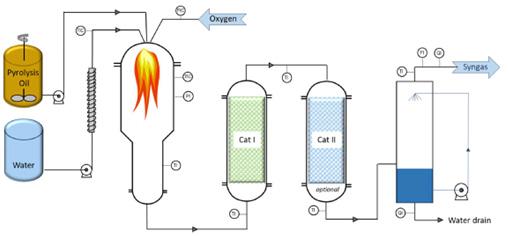
Fig 35. Schematic representation of the authothermal catalytic conversion system. Source: BTG.
Fig 36. The authothermal catalytic reformer at the BTG laboratory. Source BTG.
remaining part almost equally distributed between CO and CO2. The H2/CO ratio was near 2:1, which is a good parameter for subsequent Fischer-Tropsch synthesis. The average syngas production was around 50 mol (H2+CO)/kg FPBO, a quite close result the theoretical maximum.
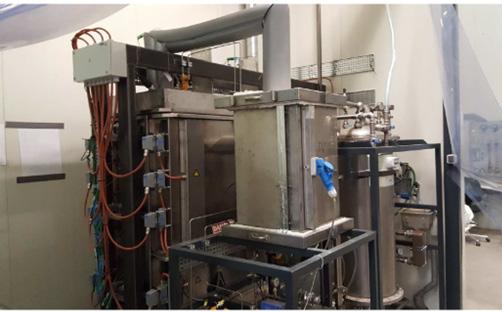
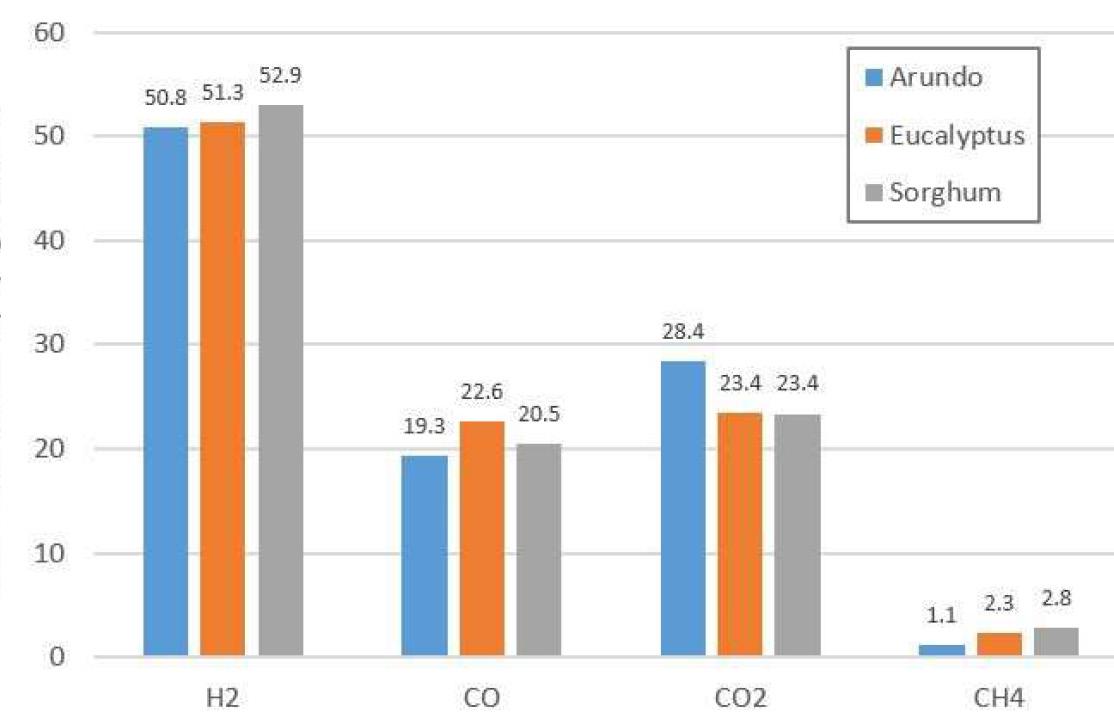
The results of the FBPO gasification tests also indicated that the final gas composition is almost independent from the type of biomass used biomass used. This is a positive outcome confirming the possibility to use fast pyrolysis as a way to increase the feedstock flexibility of advanced biofuels value chains from gasification.
Char and bio-oil slurry
In addition to the gasification of bio-oil, a potential strategy to valorize also the solid pyrolysis products (i.e. char) in a single, stablephase energy carrier, is the blending of bio-oil and char into a slurry. The slurry consists of a highly loaded suspension of solid particles in a liquid phase, with a higher energy density than pure bio-oil. In this context, partner RE-CORD investigated the formulations of slurries made by a mix of the liquid and the solid products of different pyrolysis processes of wood. These are made respectively with intermediate pyrolysis charcoal (IPC) in intermediate pyrolysis bio-oil (IPBO) and slow pyrolysis charcoal (SPC) in fast pyrolysis bio-oil (FPBO). The main research focused on the methodology for the preparation of the slurries and their characterization, with the aim of studying the slurring ability of various samples at different char-in-oil contents. The properties of the slurry are affected by the char content, the particle size and the temperature. By increasing the char-in-liquid fraction, the energy density increases as well as the dynamic viscosity.
Full line demonstration of gasification to Fischer-Tropsch liquid process
Fig 37. Composition of syngas obtained from the gasification of FBPO from different feedstock. Another major achievement of this component of BECOOL was the successful demonstration at pilot scale of a fully integrated line of Fischer Tropsch liquid
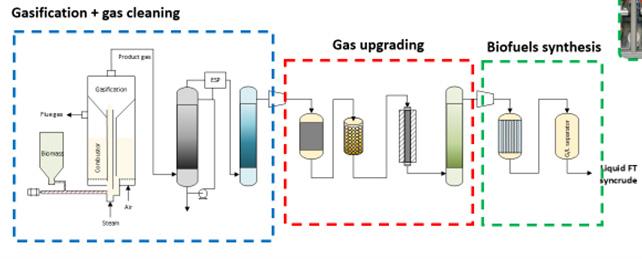

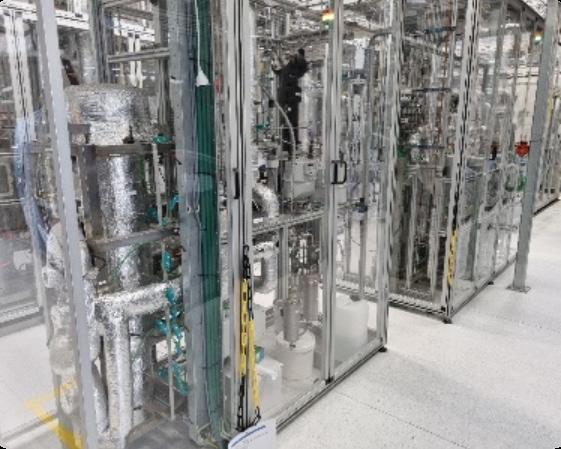
Fig 38. Scheme of the gasification and FT process (above) and images of the different sections. Source: TNO.
production from the gasification of sugarcane bagasse and wood chips. This was obtained at TNO’s laboratories using its pilot units for gasification and gas cleaning, together with gas upgrading and liquid synthesis at a rate of 1 - 1.5 Nm3/h gas. The initial objectives of this demonstration were to use a mix of wood and lignocellulosic biomass, obtaining a complete removal of tar, sulphur nitrogen and CO2 from the syngas, then use conventional pellet catalysts in conventional LTFT to synthesize the liquid fuels. The test was successful in obtaining the complete removal of sulphur and CO2 capture from the product gas, and to perform steam reforming to achieve desired H2/CO ratio. The FT pilot reactor was run in continuous for 5 days of and the first batch of liquid biofuels was yielded an amount over 3.5 liters of liquid/solid hydrocarbons. Conclusions
As the demand for biofuels is expected to increase significantly in the near future as result of the EU Green Deal objectives, the Fit-for-55 package and the need to reduce fossil fuel imports, gasification routes to advanced biofuels can represent an alternative to current biofuel processes. The special strength of these routes are the wide range of feedstocks that can be used, and the synergies that can be built with the existing current petroleum routes. In addition, gasification process allow chemical co-production for example of biomass-to-x products and alternative such as such as methanol and dimethyl ester (DME). BECOOL obtained the successful gasification of lignocellulosic feedstock and demonstrated the full line of gasification to Fischer Tropsch biofuels at pilot scale . The use of liquid intermediate energy carriers
such as pyrolysis oil as feed for gasification widens the feedstock base and removes the ash-related obstacles. The type of biomass feedstock does not affect the main FT product quality and the synthesis gas composition. The integration of biochar in the production

Fig 39. The batches of FT fuels (right). Source: TNO. route not only increase the energy efficiency of the value chain, but perfectly matches the latest provisions of REDII - Implementing Act and contributes to further improve GHG performances of the biofuel.

Fig 40. The TNO team working at the FT demonstration.
REFERENCES
Gasification of Solid Fuels for Production of Advanced Biofuels: Update, BECOOL Deliverable 3.9. Boymans E.H., Vreugdenhil B.J., 2021
Report on the gasification of liquid intermediates to syngas, BECOOL Deliverable 3.7., Leijenhorst E.J., van de Beld B., 2020
Gasification of Solid Fuels/Slurry for Production of Advanced Biofuels, BECOOL Deliverable 3.5. Boymans E.H., Abelha P., Vreugdenhil B.J.2019.
A Value Chain for Large Scale FT Production: the Case of Pyrolysis Oil-char Slurry Gasification. Boymans, E., Vreugdenhil, B., Abelha, P., Buffi, M., Chiaramonti, D., Proceedings of the 27th European Biomass Conference and Exhibition, 2019.
Improving Bio-oil Quality by Fractional Condensation of Partially Upgraded Fast Pyrolysis Vapors. Dell’Orco, S., Wilson, N., Peterson, B., Engtrakul, C., Orton, K., Chiaramonti, D., Magrini, K.A., Proceedings of the 27th European Biomass Conference and Exhibition, 2019.
A Value Chain for Large Scale FT Production: the Case of Pyrolysis Oil-char Slurry Gasification. Boymans, E., Vreugdenhil, B., Abelha, P., Buffi, M., Chiaramonti, D., Proceedings of the 27th European Biomass Conference and Exhibition, 2019.
• Successful gasification of eucalyptus, fiber sorghum, giant reed and sugar cane bagasse was achieved. • Beech wood and sugarcane bagasse were successfully converted into liquid Fischer-Tropsch products via the BECOOL process during 10 days of operations • The use of liquid energy carriers such as FBPO as feedstock for gasification widens the feedstock base for advanced biofuels and enables synergies and integrations with existing fossil routes. • The process allows chemical co-production (e.g. BTX) and alternative products such as MeOH and DME. • The GHG performance of the biofuel chain is improved by the production of biochar
